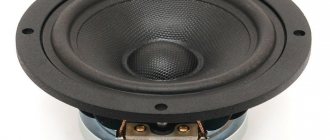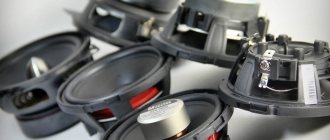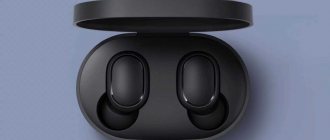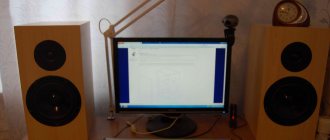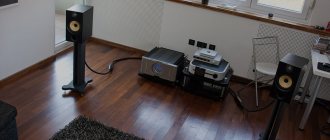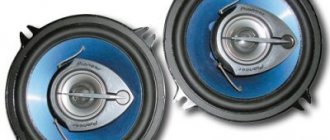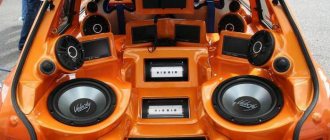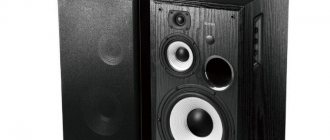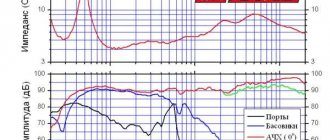Every motorist dreams of good acoustics in their car. For some, the main requirement for the system is the rattling of the windows of houses they pass by. Others prefer the most authentic sound, detailed sound image, rich bass. However, most car enthusiasts simply cannot formulate their desires. In this case, the ideal installation option in the car is wideband speakers. They are characterized by acceptable sound, are not intimidated by the cost, and if you choose the right parameters, they will delight you with really good sound.
Device
Wideband acoustics in cars has a simple design. In the most inexpensive version, this is a large-diameter speaker. It has a special design:
- the diffuser coil generates a strong magnetic field for fast movement over relatively long distances;
- The diffuser is made from classic or modern materials of high rigidity. This can be paper with special impregnation or multilayer polymer film;
- the design necessarily uses a powerful permanent magnet;
- Along the contour of the diffuser there is a shock-absorbing block made of soft rubber. It is responsible for the quality factor of the system; the higher it is, the better the broadband speakers sound.
Such a simple design causes a lot of controversy among audio specialists. Some people speak out about almost zero phase distortion during playback. This is a true statement, since the sound comes from one point and there is no overlap of waves, as happens in multi-way acoustics with several speakers.
However, purely technical and physical processes do not allow us to confidently reject the negative statements of audiophiles. No speaker, no matter how good, is capable of performing equally across the entire spectrum of audible frequencies. There are definitely dips in the upper and lower zones. The simplest broadband speaker physically cannot reproduce rich bass and subtle shades of sound on the verge of audibility.
To neutralize the disadvantages of flat sound, coaxial acoustics were created. This is an advanced broadband system. In design:
- large main speaker;
- a small speaker located inside a large diffuser;
- frequency filter system.
The operating principle of the system is quite simple. Using a frequency filter, the reproduction range of a large speaker is shifted to the bottom (bass and mids). At the same time, a small speaker operates in the upper audibility range.
The option of coaxial placement of speakers was also not chosen by chance. With this scheme, the overall acoustic background is characterized by minimal phase distortions. The coaxial full-range speaker actually reproduces sound better than its predecessors of the simplest design.
Broadband speakers of the coaxial type have not become inconvenient to use with increasing sound quality. It is just as easy to install it in the car in the standard places provided, there is no need for complex adjustment of the position and sound level, and there is no need for an amplifier with separate channel control. This scheme is loved by car owners; literally, “screw it on and it works.”
Full range speaker design
Speakers and columns that are produced using this technology may differ in appearance from each other depending on the standards adopted by the brand. Expensive models are characterized by the absence of distortion, including in the low-frequency range. To do this, manufacturers use a box that increases bass. These speakers are equipped with amplifiers with a power of up to 3 W.
Acoustic systems of this type are produced in the form of floor-standing or bookshelf speakers. They have two speakers. They use a paper diffuser. This element is responsible for reproducing the nuances of sound - from beats to vocal parts. In broadband equipment, speakers are also installed that are responsible for the high-frequency range, but these elements differ from those built into other types of acoustic devices.
The synthetic material Kevlar is also used to make the diffuser. In the Kondo RUTHY-1-2-4 and Ongaku speakers models, genuine leather was used for this element. All three materials provide clear sound from the device.
Audio Note Ruthy 5 Kondo speakers
The lightweight diffuser in these speakers conveys the subtle nuances of music, including the sound of strings and keyboard instruments. Therefore, it is believed that these devices are suitable for listening to classical and popular music (and for hard rock you need to select speakers of a different type).
Car audio with only wideband speakers rarely suits car enthusiasts. Music lovers install additional components. For example, they buy subwoofers for cars. These speakers are designed to produce low frequencies. In acoustic equipment, the subwoofer produces rich bass. These 6x9 speakers can be purchased separately.
Subwoofers are either active or passive. Active devices are produced in a ready-made case, equipped with an amplifier and a crossover of suitable parameters. Passive subwoofers are not equipped with additional elements.
crossover for acoustics
A crossover is a device that divides the frequency spectrum. This element consists of an inductor and a capacitor tuned to specified frequencies. The capacitor is responsible for the high-frequency range, the coil for the low-frequency range. In coaxial and component type acoustics, the crossover is installed during assembly. The more channels in a crossover, the richer the sound this component produces. The crossover can be purchased separately from the subwoofer and connected to car speakers.
Advantages and disadvantages
If you immerse yourself in a discussion on any auto audio forum, you can easily get confused and lost in a sea of arguments for and against wideband acoustics. Therefore, it is reasonable to immediately give the advantages and disadvantages of such solutions. The undoubted advantages include:
- absence of phase distortion (both a simple speaker and a coaxial column have this feature);
- sound output from the point region (no need to select the position of the system, no need to adjust the volume in the lower and upper regions of the frequency range);
- no special adjustment of parameters is required;
- no signal distortion due to the use of independent crossovers.
Users who like wideband speakers claim that they have a special, airy, truly good and natural sound. But systems of this class also have disadvantages:
- In any embodiment, the tonal balance has dips in the low frequencies.
- Mid frequencies sound quite flat. The reason is physical processes that do not allow the large cone of the main speaker to quickly respond to signal changes.
- The cheaper the system, the more noticeable the drop in playback quality is. In the most budget models, part of the sound image will simply disappear or sound incorrect.
Listening to audiophiles, you might think of a full-range speaker as an old, clunky black-and-white TV. In practice this is not the case. If you choose models with good characteristics, the car will sparkle with sound, since wideband acoustics work great in confined spaces.
How to choose
The popularity of the broadband speaker among motorists can be understood by the many models offered on the market. But when choosing your ideal acoustics, you don’t need to follow the lead of dishonest marketers.
The average coaxial full-range speaker has one or two crossovers and a pair of drivers. This allows:
- maintain air passage from the main speaker, provide more vibrant bass and intelligible mids;
- expand the frequency range.
But today you can find anything on the market. From three-way to six- and eight-way coaxial speakers. In place of one small tweeter there is often a large head with several sound emitters. You shouldn’t agree with the not entirely correct opinion that “more stripes are better.” In practice this means the following:
- with multiband filtering, only two crossovers or a circuit with parallel circuits are often used;
- a head with several sound emitters in the center of the main speaker closes the space for sound passage, which negatively affects its quality.
Thus, there is absolutely no need to chase the number of bands that broadband coaxial speakers for cars have. It is wise to pay attention to the technical specifications.
Frequency
Manufacturers always indicate the range of reproduced frequencies. When choosing broadband acoustics for a car, it is worth remembering the gaps in the lower and upper audibility zone. You need to buy a model with the widest possible range. Ideally, if its lower limit is less than 20 Hz, and its upper limit is close to 48000 Hz.
Sensitivity
Most car speakers have a sensitivity of about 90 Hz. This value is enough if you plan to make a really good sound in the car by installing a high-quality amplifier. If the playback device cannot boast of significant output power, it is worth looking for acoustics with greater sensitivity.
But you shouldn’t choose record values, for example, 150 or higher. In this case, the speakers react too clearly to various radio and electrical interference, of which there is plenty in the car.
Size
The sizes of full-range speakers are selected in accordance with the standard places for their installation provided in the car. Most car owners follow exactly this tactic. It is not a good idea to try to modify areas for installing acoustics without proper experience. This can not only degrade the performance of the interior, but can also lead to a decrease in sound quality due to sealing problems and other errors.
Rated and peak power
When buying speakers for a car, you should focus solely on the nominal figure. This value shows at what power supply the acoustics will reproduce sound without distortion for any length of time.
Peak power is the maximum operating mode of the acoustics. According to production testing standards, the cone coil and other speaker circuitry can withstand maximum currents for 5 minutes. Therefore, it is recommended to ignore the peak power parameter and select acoustics only according to the nominal indicator.
Resonance frequency
The resonant frequency indicator is almost similar to the cutoff of subwoofer systems. For broadband acoustics, the lower the indicator, the deeper bass it can reproduce.
Full quality factor
This parameter is purely physical. It describes the ability of the contoured rubber diffuser block to maintain the amplitude of vibration. Based on the value of the total quality factor, speakers are selected for enclosed spaces, for example, those installed in doors. If the value is between 0.4 and 0.6 (low), the sound will be flat and unimpressive. Therefore, it is recommended to purchase models with the highest possible quality factor.
The last parameter of any acoustics is the electrical resistance of the system, or impedance. You need to buy a speaker with the value of this indicator that is indicated in the technical data sheet of the amplifier. In simple words, if it is written that the playback system produces 100 W per channel with a resistance of 4 Ohms, it is the acoustics with this impedance that you should buy. This will reduce signal distortion and avoid emergency operation of the amplifier.
What are full range speakers
The human ear is capable of perceiving a frequency range from 20 Hz to 20 kHz. For this purpose, wideband speakers have been created - these are devices that are capable of reproducing this range without separation. But at the border of the high- and low-frequency range, these speakers transmit sound worse than the middle of the spectrum. This is due to the design of the device.
In standard speakers, the size of the diffuser is increased for low-frequency reproduction. For example, a diameter of 30 cm provides a frequency transmission of 40 Hz. But then another problem arises. With such a speaker diameter, transmission in the high-frequency range deteriorates, because the diffuser does not have enough time to transmit vibrations to the surface.
This led to the development of modifications. The design of the models may additionally include a high-frequency diffuser that operates faster than a universal one. All models of full-range speakers on the market can be divided into two groups:
- Devices with a central cap . This is a standard speaker consisting of a single cone-dome.
- Devices with a cone-visor , which is called a bullhorn or pipe. This design is easy to understand. The horn has a small diameter and is built inside a wider cone. Such a sighting cone quickly picks up vibrations.
When choosing this speaker, it is important to buy a device that will clearly reproduce sound in the audible range, which is from 60 Hz to 16 kHz. The technical brevity of the design does not harm the device. On the contrary, it increases the reliability and sensitivity of the device to 90-92 dB. The resistance of the voice coils is higher than that of similar devices using other technologies.
In acoustics, there is the concept of a point source of sound - this is an object with such localization, the direction of which the listener can accurately detect. Wideband speakers have characteristics close to those of a point sound source. This is the secret of popularity.
Most often, such acoustics are used in cars. Through these speakers you can listen to the radio and music recordings, and these devices are inexpensive. But this technology is used not only in cars. These speakers are installed in portable speakers, televisions, etc.
Components of a Quality System
In modern cars, you can quite unexpectedly find a large number of standard places for installing speakers. For example, they are in the doors, front roof pillars, and in the dashboard. This is done to accommodate component acoustics. But you can build a system with high-quality sound using wideband speakers. This will require additional components.
Subwoofer
The subwoofer is designed to operate exclusively in the low frequency band. It forms the same juicy bass that many people love. This device must be located either in the trunk or behind the back of the rear row of seats. Today, models are available that can be placed under the seat.
There is only one rule for the location of the subwoofer: it should be located at the back. This will distribute the vibrations throughout the cabin, without creating an area where the bass clogs the rest of the sound image.
Crossover
The purpose of a crossover is to separate frequencies. Roughly speaking, this is a multifunctional filter. The crossover can be single-channel, configured for a narrow bandwidth. But to build a good multi-point audio system in a car, it is recommended to buy more advanced models.
A standard crossover divides the signal into three bands: bass, middle bass, and treble. They are connected to playback points as follows:
- bass - to the subwoofer;
- middle bass - for the door and dashboard speakers;
- top - on the acoustics in the roof pillars.
The advantage of using a crossover is that its output signals can be converted in any way you like. For example, installing separate amplifiers for the sub, mid-frequency and high-frequency playback circuits.
Voight Trumpet
In 1930, Paul Voight described a new principle for creating an acoustic system, the so-called Tapered Quarter-Wave Pipe (TQWP). This horn system uses the resonance frequency of the driver.
The advantage of the acoustic principle is the absence of separation filters. The horn and the speaker are separated, that is, the placement of the speaker is not the beginning of the horn, but its side. The horn acts as a return load for the diffuser.
And again, our radio amateurs built Voight pipes, again!, on 4A-28 speakers.
Rating
User preferences are the best source for ratings, as opposed to advertising materials and marketer opinions. The volume of purchases made it clear to motorists which models of broadband speakers are in demand and allow them to get good sound in the car.
Pioneer TS-MR1600
pros
- durable body;
- protection from water and dust;
- pleasant sound;
- good sound in the wind.
Minuses
- you have to overpay for protection that is not needed in the car;
- the body looks rough;
- low rated power.
From 3200 ₽
This model is designed for installation on boats, yachts and other vehicles where the acoustics are affected by water and dust. The speakers are coaxial type, two-way, 6-inch mounting diameter. Frequency range 30–30000 Hz, sensitivity 90 dB, rated power 25 W.
Pioneer TS-1701I
pros
- attractive price;
- good bass;
- quality of workmanship and materials;
- good detail of the sound picture.
Minuses
- in some cars it is difficult to put them in their regular place;
- shortcomings of high frequencies, flat, from afar;
- in some machines the rated power may be insufficient;
- complex sound picture, rich music is not reproduced well enough (interference, distortion, garbage).
From 1167 ₽
This model has a successful design with a small tweeter and large space for the passage of waves from the main emitter. Size 6 inches, 90 dB sensitivity, rated power 35 W, frequency band 32-19000 Hz.
JVC CS-J610
pros
- price;
- quite good sound;
- acceptable power;
- coverage of almost the entire declared frequency range;
- stylish appearance.
Minuses
- no safety net;
- body rattling at high volume;
- do not work well in confined spaces (doors);
- the sound is dry.
From 955 ₽
This budget acoustics is made in an interesting, stylish case. Reproduces all frequencies and plays quite cleanly. Ideal for small and medium-sized cars. It has good sensitivity of 92 dB, declared frequency band 35–20000 Hz. Bore diameter 6 inches, rated power 30 W.
JVC CS-V618
pros
- good sound;
- coverage of the declared frequency band;
- branded stylish case with a protective mesh;
- Low height simplifies installation.
Minuses
- dry sound;
- rattling at high volume;
- low rated power;
- do not work well in confined spaces.
From 1320 ₽
Budget coaxial speakers that are perfect for a medium-sized car. When installed on the rear shelf, protective nets have a huge advantage, protecting the speaker from debris and mechanical damage. The model has a standard size of 6 inches, two bands, rated power 30 W, frequency range 42–20000 Hz.
